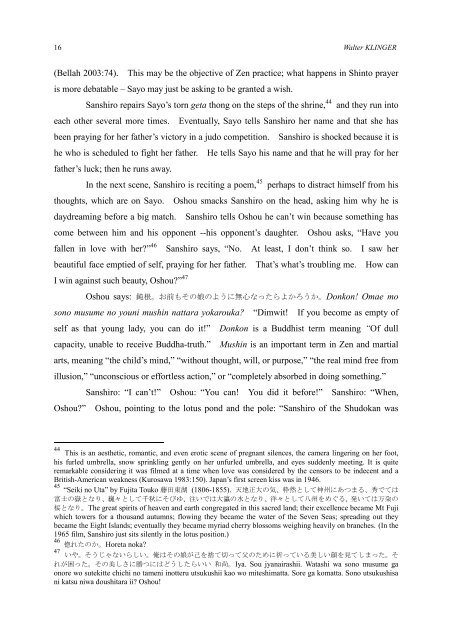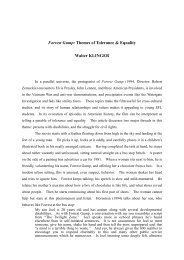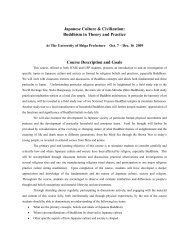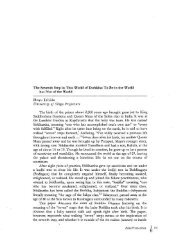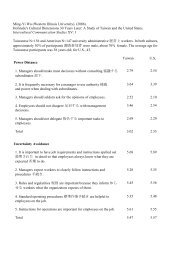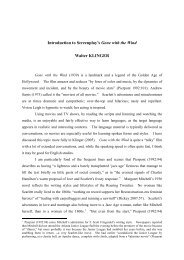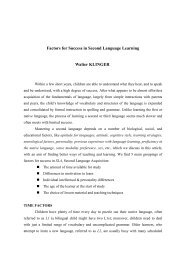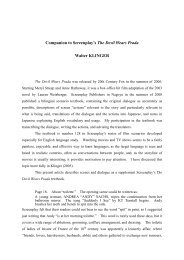Create successful ePaper yourself
Turn your PDF publications into a flip-book with our unique Google optimized e-Paper software.
16 <strong>Walter</strong> <strong>KLINGER</strong>(Bellah 2003:74). This may be the objective of Zen practice; what happens in Shinto prayeris more debatable – Sayo may just be asking to be granted a wish.Sanshiro repairs Sayo’s torn geta thong on the steps of the shrine, 44 and they run intoeach other several more times. Eventually, Sayo tells Sanshiro her name and that she hasbeen praying for her father’s victory in a judo competition. Sanshiro is shocked because it ishe who is scheduled to fight her father. He tells Sayo his name and that he will pray for herfather’s luck; then he runs away.In the next scene, Sanshiro is reciting a poem, 45 perhaps to distract himself from histhoughts, which are on Sayo. Oshou smacks Sanshiro on the head, asking him why he isdaydreaming before a big match. Sanshiro tells Oshou he can’t win because something hascome between him and his opponent --his opponent’s daughter. Oshou asks, “Have youfallen in love with her?” 46 Sanshiro says, “No. At least, I don’t think so. I saw herbeautiful face emptied of self, praying for her father. That’s what’s troubling me. How canI win against such beauty, Oshou?” 47Oshou says: 鈍 根 。お 前 もその 娘 のように 無 心 なったらよかろうか。Donkon! Omae mosono musume no youni mushin nattara yokarouka? “Dimwit! If you become as empty ofself as that young lady, you can do it!” Donkon is a Buddhist term meaning “Of dullcapacity, unable to receive Buddha-truth.” Mushin is an important term in Zen and martialarts, meaning “the child’s mind,” “without thought, will, or purpose,” “the real mind free fromillusion,” “unconscious or effortless action,” or “completely absorbed in doing something.”Sanshiro: “I can’t!” Oshou: “You can! You did it before!” Sanshiro: “When,Oshou?” Oshou, pointing to the lotus pond and the pole: “Sanshiro of the Shudokan was44 This is an aesthetic, romantic, and even erotic scene of pregnant silences, the camera lingering on her foot,his furled umbrella, snow sprinkling gently on her unfurled umbrella, and eyes suddenly meeting. It is quiteremarkable considering it was filmed at a time when love was considered by the censors to be indecent and aBritish-American weakness (Kurosawa 1983:150). Japan’s first screen kiss was in 1946.45 “Seiki no Uta” by Fujita Touko 藤 田 東朁 湖 (1806-1855). 天 地 正 大 の 気 、 粋 然 として 神 州 にあつまる、 秀 でては富 士 の 嶽 となり、 巍 々として 千 秋 にそびゆ、 注 いでは 大 瀛 の 水 となり、 洋 々として 八 州 をめぐる, 発 いては 万 朶曙 の桜 となり。The great spirits of heaven and earth congregated in this sacred land; their excellence became Mt Fujiwhich towers for a thousand autumns; flowing they became the water of the Seven Seas; spreading out theybecame the Eight Islands; eventually they became myriad cherry blossoms weighing heavily on branches. (In the1965 film, Sanshiro just sits silently in the lotus position.)46惚 れたのか。Horeta noka?47 いや。そうじゃないらしい。 俺 はその 娘 が 己 を 捨 て 切 って 父 のために 祈 っている 美 しい 顔 を 見 てしまった。それが 困 った。その 美 しさに 勝 つにはどうしたらいい 和 尚 。Iya. Sou jyanairashii. Watashi wa sono musume gaonore wo sutekitte chichi no tameni inotteru utsukushii kao wo miteshimatta. Sore ga komatta. Sono utsukushisani katsu niwa doushitara ii? Oshou!


